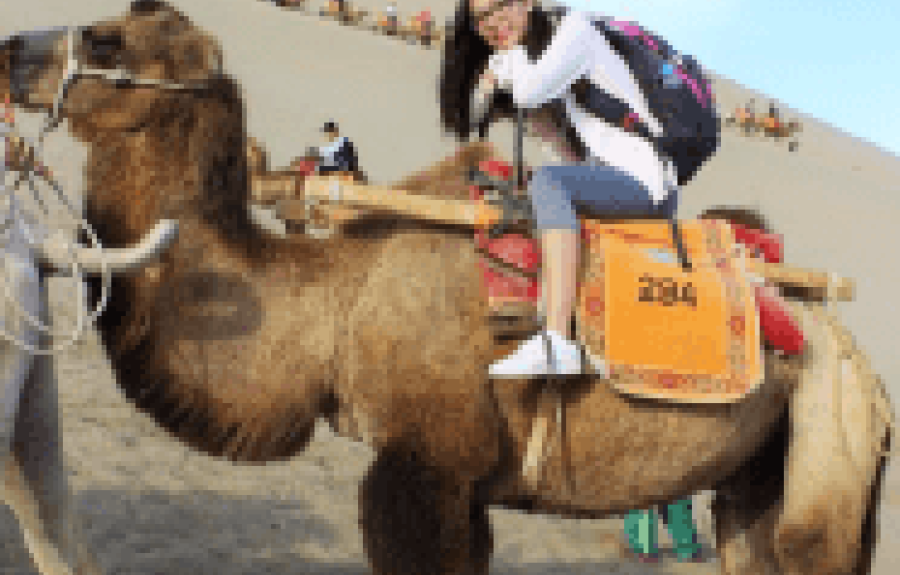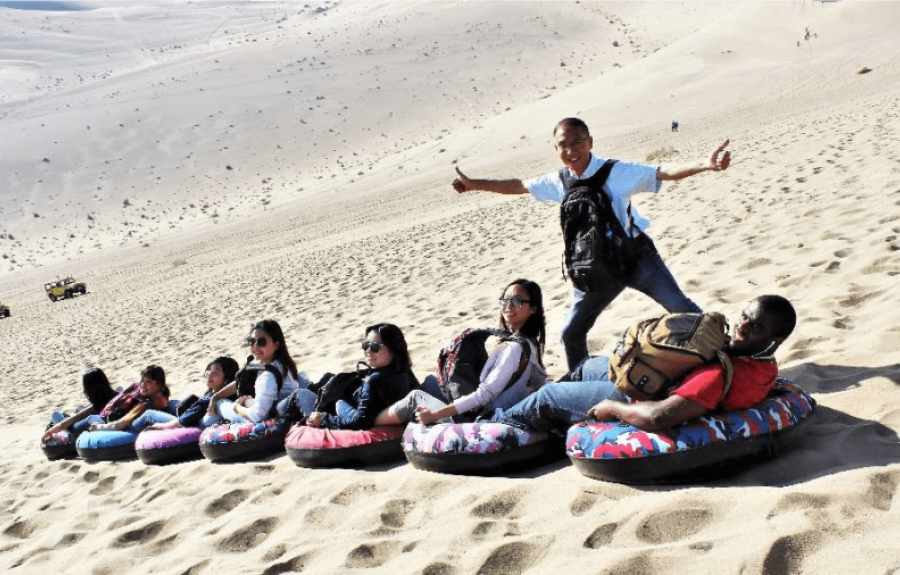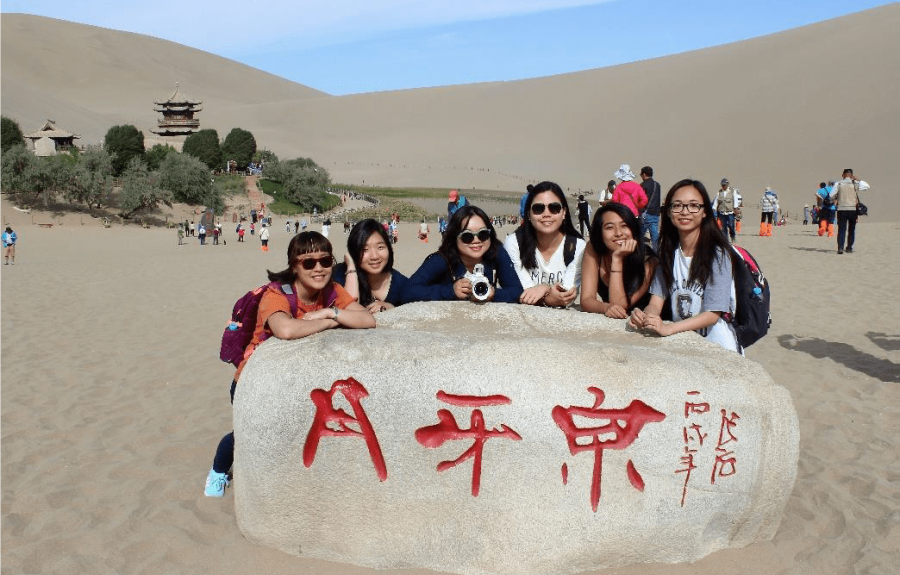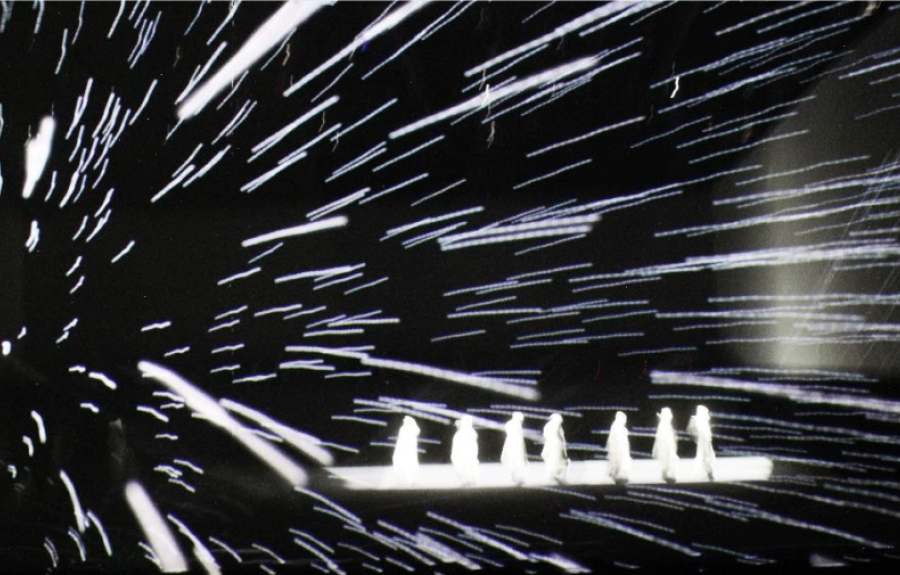Wendy Chen '19: Field Trip to Dunhuang, Gansu Province 甘肃省, 敦煌市 Fall 2017
During the four-day trip to Gansu 甘肃, I learned and explored much of the culture of Gansu, a province in China’s northwest, from the Gobi Desert to lamb skewers 羊肉串 to Jiayuguan 嘉峪关 Pass. My favorite day by far was the busiest day of the trip, Saturday September 2nd, a day of adorable camels, large sand dunes, breathtaking Buddha statues, and a beautiful local performance in Dunhuang 敦煌.
After waking up with the sunrise and getting breakfast, we drove from our hotel to one of my favorite places during this trip: Mingsha Shan 鸣沙山. As our car approached the edge of the city of Dunhuang where it borders the desert, my grogginess disappeared. From a distance, you can see the tall sand dunes of the desert where the road meets the sky, above the green trees and modern structures of the city, and as you move towards the edge, the sand dunes become bigger and bigger. It was an absolutely fascinating sight to see and be on the edge of the desert sand and the concrete city. Getting off the bus and approaching the edge by foot, watching the sand dunes up close, lifted my spirits despite the small amount of sleep I got the day before and put me a great mood.
The first activity of the day was to ride a camel! The camels will carry you up and down the sand dunes in a path for you to experience how people in the past travelled in the Dunhuang and the desert. I thought the camels were cute with their fluffy coat of fur and long lashes despite their rotten and crooked teeth, and incessant, perfectly round ball of poop, and was extremely excited but nervous to ride on one. Camels are pretty tall, around 6 feet for adults, and falling off the camel would be very suboptimal. They’re graceful as they walk on the desert sand, their 2 padded feet stepping and lifting off the sand in an advantageous fashion so they do not sink like humans do. However, camels standing up and sitting down are not as elegant; A camel stands up with its hind legs first, then its front legs, while it sits down with its front legs, then its hind legs. This may work for the camels, but it does not prove to be very elegant nor simple for the rider. As my camel stood up, I held the saddle bar in front of me tightly, putting strength into my arms to brace for the rocky start. As my camel sat down, the motion made me even more nervous since it felt like I was going to roll off and over the camel’s head as he dipped forward to sit.
The ride was quite wobbly, my body moving from side to side slightly as the camel moved forward. It was nothing like I had ever done before either, so I never let go of the metal bar of the saddle for comfort and security as I adjusted to the rhythm of riding a camel. Soon enough, I got used to the soft sway of my ride and dared to take out my phone for some beautiful scenic pictures of the trails of camels on sand dunes against a clear blue sky, with the warning of “you will not get anything back if you drop it into the sand” in the back of my mind.
After my camel made its way to the top of a sand dune, I dismounted to join everyone for some pictures in the soft sand and blue sky and all walked up another sand dune to sand sled. Walking in the sand was incredibly tiring, each step was extremely taxing on the body, but it was so worth it. The eight of us got into sledding tubes that were linked to each other and down we go. I cheered as the adrenaline pumped through me, as the wind whipped my hair back, as the small individual grains of sand pelted my face and lodged itself into every single exposed surface of my body and clothes. Still, it was an amazing ride that was much too short for my (and some other people’s) liking, inciting cheers of “one more time!” and “let’s do it again!” as we got off our tubes and tried to shake the sand off of us to no avail. However, due to time constraints in the packed day, we slipped back onto our camels for the ride 3 down the sand dunes. After taking a selfie with Ziggy, I regrouped with everyone and we went to see the watery oasis in the desert, Crescent Lake 月牙泉, for many scenic pictures before heading off to lunch.
After lunch, we headed off to the Dunhuang Mogao Grottoes 莫高窟, caves that served as places of worship for Buddhism. With over 700 caves, we had the opportunity to view a few of the caves in person with a tour guide explaining the contents through a radio earpiece attached to my ear. When I first stepped into a cave, my breath was taken away by the amazing statues, art, and murals that covered every single inch of the cave’s walls and ceilings. A statue of Buddha is generally in the middle as the focus of the cave and surrounded by Bodhisattvas 菩萨 and his disciples. Colorful art and murals are painted everywhere, often depicting various deities and stories such as the prince who sacrificed his life selflessly to serve himself as food for a hungry tigress and her subs. Designs of Buddha pattern the cave, often with darkened skin instead of flesh colored skin due to the passage of time and sometimes with gold lining to accentuate the extravagance and dedication of the artisans who created and decorated the caves. Not only were the colors used for the cave vivid and well preserved, the sculptures and everything within were intricate and detailed, requiring much time and work to create even one beautiful small cave that we see today.
Each small cave that we went to were beautiful, but the sheer size of some caves and its contents make my mouth drop. A statue of a large Buddha lying down, surrounded by his disciples, flabbergasted me. The statue was over 15 meters long, with his disciples looking very small in comparison. This cave reflected Buddhist teachings of reincarnation and the cycle of life and death very well. The Buddha has died, and his disciples surround him, all wearing different 4 faces with different emotions. The disciples that were grieving and sad about Buddha’s death did not learn and understand his teachings and philosophy well because they did not understand reincarnation and the cycle, while whose who were not bothered and content had learned from Buddha well because they know that he is in a better place and will be back in the world again to continue the cycle of reincarnation. The philosophy and teaching behind this cave was extremely interesting to me and intrigued me a lot.
When I first stepped into one of the last caves we toured, I just saw a small part of the bottom of the statue and was very confused. With every step that I took towards the statue, I had to crane my neck a little bit higher every time to see the full grandeur of the nine-story tall Buddha statue housed in a red wooden structure. Without even discussing the details and craftsmanship of the statue, its sheer size awes me. How in the world did people from the past build these huge structures and paint intricate murals in the Mogao Grottoes when I can only draw stick figures? It never ceases to amaze me, the effort and dedication of the artisans of the past to produce the World Heritage Site we see today.
 After a great dinner and a short break, we went to a theatrical performance in Dunhuang. Not originally in the itinerary, the show 又见敦煌 was recommended by our tour guide. The director is Wang Chaoge 王潮歌, one of China’s top directors, and is about the history of Dunhuang. It highlights significant figures of the past and intertwines their stories with a modern-day narrator. The timelines and characters from the different periods of time interact and discuss certain events and consequences. The show itself was extremely unique in its storytelling and its stage. There were four acts of the show, each in a different room and the first three required people to move around since the performance is not only on a singular stage, but in many different directions all around the room. The audience can become very close to the actors as they perform. Only until the final act in the last room was there a traditional audience seating arrangement in front of a singular stage. However, even then, Director Wang makes it unique in performance, combining projection technology and smart lighting techniques with the actors on stage. Throughout, there is song, there is monologue, there is dialogue, there is dance, there is acrobatics; it is a truly unique way of telling a story.
After a great dinner and a short break, we went to a theatrical performance in Dunhuang. Not originally in the itinerary, the show 又见敦煌 was recommended by our tour guide. The director is Wang Chaoge 王潮歌, one of China’s top directors, and is about the history of Dunhuang. It highlights significant figures of the past and intertwines their stories with a modern-day narrator. The timelines and characters from the different periods of time interact and discuss certain events and consequences. The show itself was extremely unique in its storytelling and its stage. There were four acts of the show, each in a different room and the first three required people to move around since the performance is not only on a singular stage, but in many different directions all around the room. The audience can become very close to the actors as they perform. Only until the final act in the last room was there a traditional audience seating arrangement in front of a singular stage. However, even then, Director Wang makes it unique in performance, combining projection technology and smart lighting techniques with the actors on stage. Throughout, there is song, there is monologue, there is dialogue, there is dance, there is acrobatics; it is a truly unique way of telling a story.
 The first act was an introduction of the show and the characters involved. Then the audience was ushered into a different room where the story of a Taoist monk who shipped valuable historical treasures from the Mogao Grottoes away overseas. The narrator of the story was a Dunhuang researcher whose timeline crossed with the monk’s, and he begged the monk not to send the items away as most of the items never return to China. The monk ignores his advice, whether it is because the past is irreversible or because the monk did not listen. Those who helped in sending these items away covered their skin in red because it is believed that the gods will not recognize them if they did that because they recognized that their actions were bad. Anguished after the task was completed, the villagers and the Taoist monk sees the appearance of the Bodhisattvas. Elegant and gentle, the Bodhisattvas forgive everyone for what they have done. The second act ends with an acrobatic performance of sorts, with a singular Bodhisattva in the air above the villagers who collectively danced.
The first act was an introduction of the show and the characters involved. Then the audience was ushered into a different room where the story of a Taoist monk who shipped valuable historical treasures from the Mogao Grottoes away overseas. The narrator of the story was a Dunhuang researcher whose timeline crossed with the monk’s, and he begged the monk not to send the items away as most of the items never return to China. The monk ignores his advice, whether it is because the past is irreversible or because the monk did not listen. Those who helped in sending these items away covered their skin in red because it is believed that the gods will not recognize them if they did that because they recognized that their actions were bad. Anguished after the task was completed, the villagers and the Taoist monk sees the appearance of the Bodhisattvas. Elegant and gentle, the Bodhisattvas forgive everyone for what they have done. The second act ends with an acrobatic performance of sorts, with a singular Bodhisattva in the air above the villagers who collectively danced.
 The third act was my favorite solely because of the uniqueness of the stage or lack thereof. The audience members were split up into smaller groups and lead into a small room with a section of the floor as glass, a section of the ceiling as glass, and windows surrounding the walls of the room. You look down at your feet to see a wife tossing and turning in bed, worried and yearning for her husband who travelled away for work. You look up above your head to see said husband researching and digging, unable to contact and respond to his wife’s letter. You look around the walls to see the beautiful royalty of the past, who were enamored and obsessed by their own appearance. Their portraits were drawn and displayed so their beauty can be eternalized but when a narrator from the modern day tells them that their skin in the painting has blacken due to time and environment, the royal ladies become upset. This act revolved around the vanity of these women, obsessed with beauty, asking “Am I beautiful? 我美吗?” over and over in repetition, almost to the point of creepy and psychotic.
The third act was my favorite solely because of the uniqueness of the stage or lack thereof. The audience members were split up into smaller groups and lead into a small room with a section of the floor as glass, a section of the ceiling as glass, and windows surrounding the walls of the room. You look down at your feet to see a wife tossing and turning in bed, worried and yearning for her husband who travelled away for work. You look up above your head to see said husband researching and digging, unable to contact and respond to his wife’s letter. You look around the walls to see the beautiful royalty of the past, who were enamored and obsessed by their own appearance. Their portraits were drawn and displayed so their beauty can be eternalized but when a narrator from the modern day tells them that their skin in the painting has blacken due to time and environment, the royal ladies become upset. This act revolved around the vanity of these women, obsessed with beauty, asking “Am I beautiful? 我美吗?” over and over in repetition, almost to the point of creepy and psychotic.
After, we were ushered to the last room of the final act with traditional seating and a stage at the front. The stage is still unique with its use of projection. The actors performed behind a thin screen where the projection was displayed, thin enough to see the actors behind the screen but still able for the projected images to be clear. Through the projection, the setting of the scenes was vividly and uniquely displayed in front and behind the actors, depending on the scene and character. A narrator from the modern world again interacts with the historical figures, asking them questions about themselves. A general and his army goes to war, the stage filled with the energy and adrenaline of a battlefield using drums and dance. A monk makes it from Dunhuang to the capital of China, trekking across the desert and land for two years and being the only survivor out of many to deliver the news to the emperor that the Silk Road has successfully connected with China “丝路通了!”, ushering prosperity and wealth into China since the Silk Road connects China to the rest of the world by land.
The final scene revolved around the many dynasties that ruled China and collapsed, but this outlined the significance of history since these dynasties and their unique cultures and characteristics and stories live on through history. Later, a scholar and the modern narrator exchange a dialogue that highlighted the phrase “一瞬间, a moment”. How long is a year? How long is a lifetime? How long is a thousand year? 一瞬间. Again, this highlights Buddhist ideology, in which everyone is small and miniscule in the grand scheme of the world and the cycle of life and death.
Going into the performance, I had my doubts. I did not know what to expect and honestly did not feel motivated nor excited to watch the performance. However, I appreciated the show much more upon leaving the venue, my mind working to try and absorb everything that I had just saw. It was one of the most interesting shows I have ever watched and had a certain uniqueness to it that made it so stimulating. I acknowledge that the show had layers of interpretation and culture that I do not know enough to understand. My regrets are that my Chinese language skills and knowledge of China and Dunhuang was not sufficient for me to understand the show on a deeper level, but it really opened my mind and helped me understand Dunhuang and Gansu.





